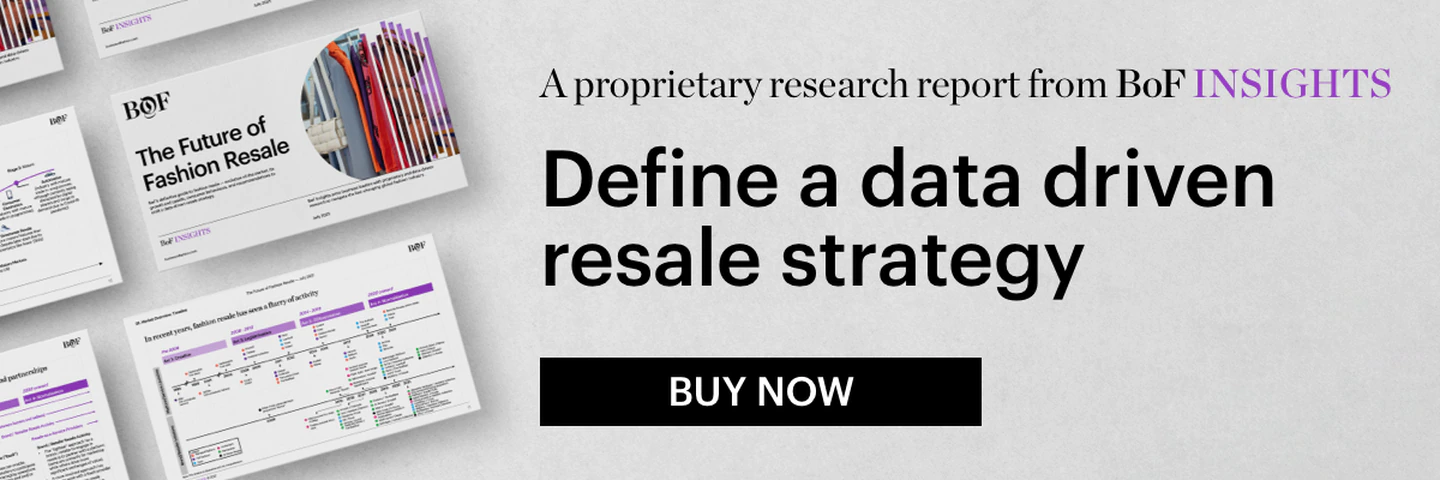
Whenever Apparis, an outerwear brand known for its faux fur, bright colours and prints, used to get messages from consumers asking for discontinued styles, it pointed them to The RealReal. But as inquiries continued to flow in, co-founder Lauren Nouchi wondered why she was sending consumers to another retailer to buy their products. Cut to this past April: it launched its own pre-owned line, ReApparis, with Recurate, a platform that helps brands launch their own peer-to-peer secondhand platforms.
“We thought it would be a better strategy to have a direct relationship with our existing customer,” said Nouchi. “We think it will encourage them to purchase again with us.”
Apparis is hardly the only retailer interested in resale, once dismissed by brands as an engine for counterfeits that has now become a rapidly-growing part of mainstream e-commerce. The US secondhand fashion market is slated to reach $57 billion by 2025, according to BoF Insights data. In 2020, resale accounted for 10 percent of all US retail sales, up from 5 percent in 2016. In the past decade, the bulk of this market has been dominated by third-party giants like The RealReal, ThredUp and Poshmark. But as the space continues to expand, brands themselves are looking to control the customer journey in the pre-owned realm. If shoppers are seeking used Apparis coats on The RealReal, why lose the sale?
This trend has given rise to a flurry of resale-as-service (RaaS) platforms that handle the backend process of a brand’s owned resale business, which includes inventory collection, verification and ultimately, sale. Some of the category’s newest entrants include Lululemon, Net-A-Porter and Hugo Boss, which all launched in April, working with RaaS firms such as Trove, Reflaunt and Faume.
Even third-party resale platforms see the potential in this B2B space. After reporting 31 percent year-over-year growth in revenue in its first quarter and 33 percent growth in active buyers on its own platform on Monday, ThredUp named RaaS a major focus in the coming year. Chief executive James Reinhart said in the earnings call that ThredUp wants to be “the go-to enabler” for brands interested in launching resale. It expects to add 40 brands to its service by the end of the year.
For brands, resale isn’t necessarily a revenue driver; it’s about being part of a consumer experience that’s happening with or without them. While retailers are betting it may eventually become a profitable part of their models, most are focused currently on resale’s potential for driving customer acquisition and loyalty.
Still, resale can be a logistical headache. Inventory is hard to come by, there’s fierce competition for merchandise. Brands have yet to find a way to meaningfully unlock what’s sitting in consumers’ closets, which BoF Insights estimates is worth around $2.1 trillion. Managed platforms like Trove and Reflaunt, which hold sellers’ inventory, require moving overhead and inventory and are more costly. Peer-to-peer options like Archive and Recurate, which allow consumers to buy and sell from each other, cut out some operational tiffs and are easier to scale because customers buy and sell with each other directly, but give the brand less control over quality and presentation. But with both options, brands still have to authenticate items themselves, which makes resale more of a challenge with higher product value items. The other choice, building a recommerce site from scratch, as Urban Outfitters did with Nuuly, requires a significant upfront investment.
Even if brands build their own shops, there are no guarantees consumers will come, as there are plenty of places to resell their products.
Though it’s trending, resale still may not be top on most fashion leaders’ to-do list amid more pressing supply chain issues. In a recent report, Kearney found that 48 percent of fashion executives surveyed said re-designing supply chains to enable take-backs and secondhand programs was considered complex to implement and prioritised it last in a series of seven sustainability objectives.
But Brian Ehrig, consumer practice partner at Kearney and author of the report, said there’s a lot at stake for premium brands that don’t start thinking about opening up resale channels.
“Your products have value and if you’re not taking control of it, then consumers or somebody else is,” said Ehrig. “That means that you’re going to lose control over the narrative of your brand in the resale space.”
Below is a look at branded resale in four charts.



